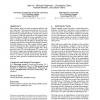20 search results - page 1 / 4 » Dynamic Taint Propagation for Java |
ACSAC
2005
IEEE
14 years 4 months ago
2005
IEEE
Improperly validated user input is the underlying root cause for a wide variety of attacks on web-based applications. Static approaches for detecting this problem help at the time...
HPCA
2008
IEEE
14 years 11 months ago
2008
IEEE
This paper presents FlexiTaint, a hardware accelerator for dynamic taint propagation. FlexiTaint is implemented as an in-order addition to the back-end of the processor pipeline, ...
EUROSYS
2006
ACM
14 years 8 months ago
2006
ACM
Many software attacks are based on injecting malicious code into a target host. This paper demonstrates the use of a wellknown technique, data tainting, to track data received fro...
KBSE
2007
IEEE
14 years 5 months ago
2007
IEEE
Programs written in languages that provide direct access to memory through pointers often contain memory-related faults, which may cause non-deterministic failures and even securi...
IEEEARES
2009
IEEE
14 years 5 months ago
2009
IEEE
Dynamic taint analysis (DTA) is a technique used for tracking information flow by propagating taint propagation across memory locations during program execution. Most implementat...

